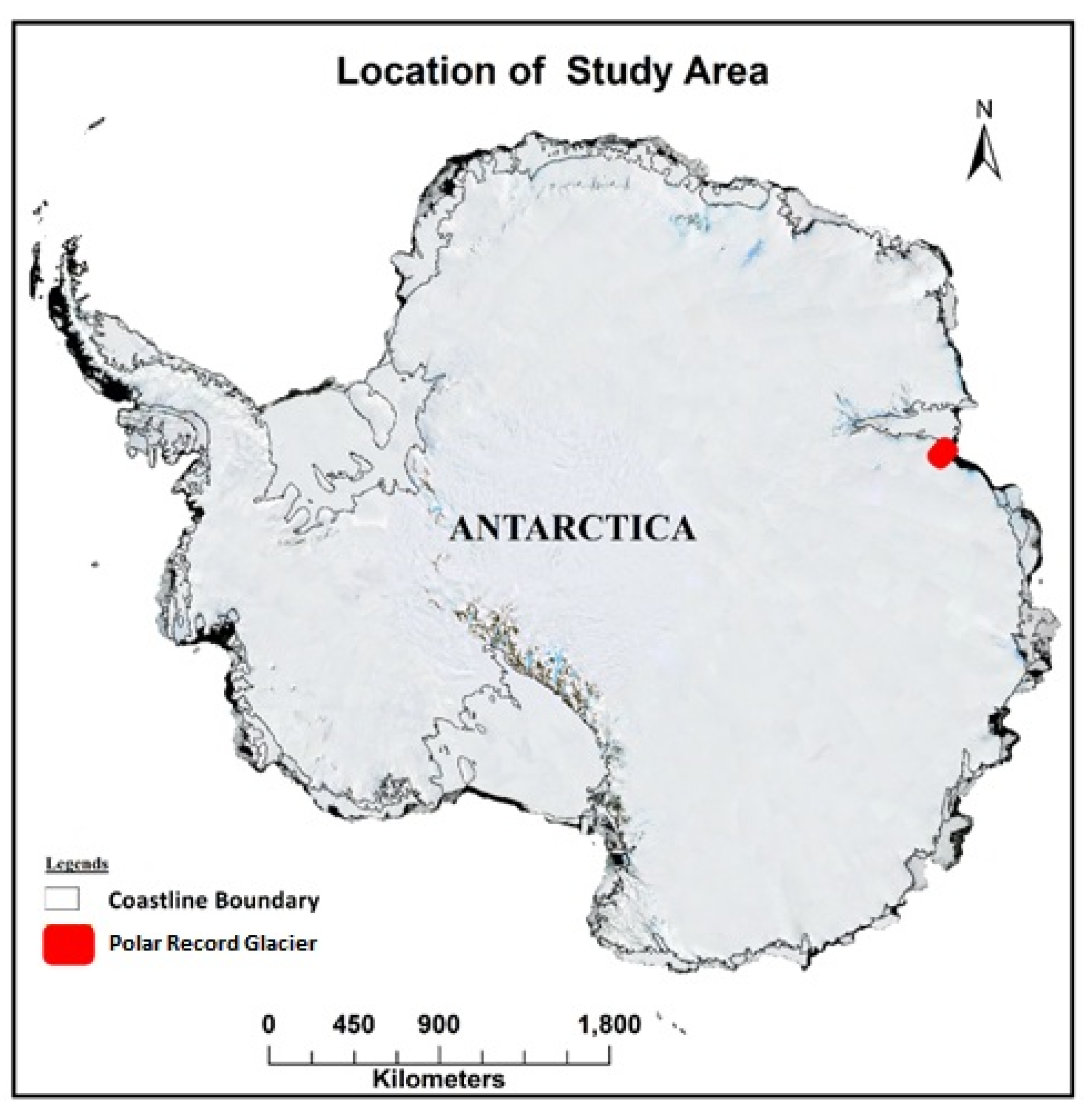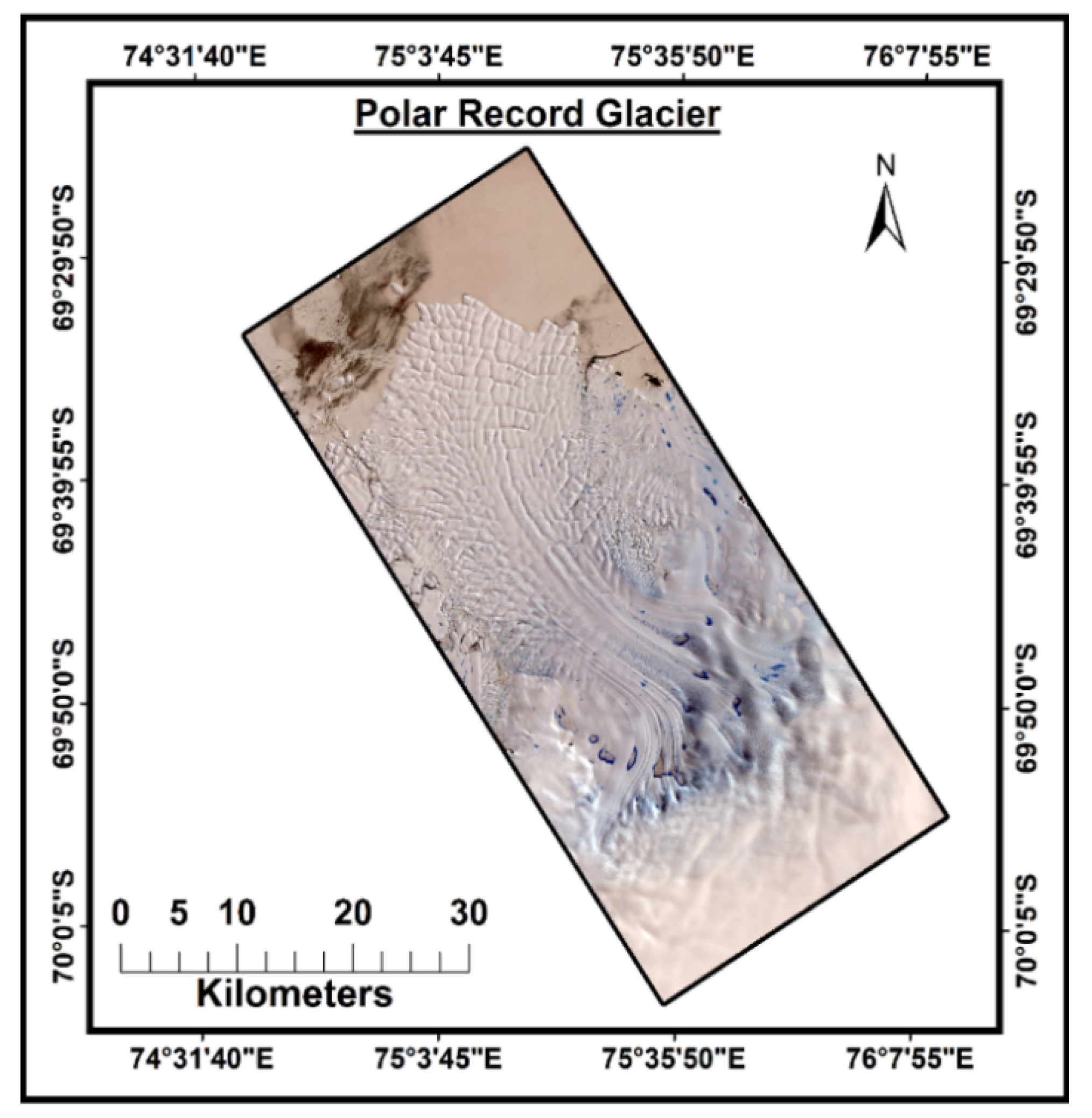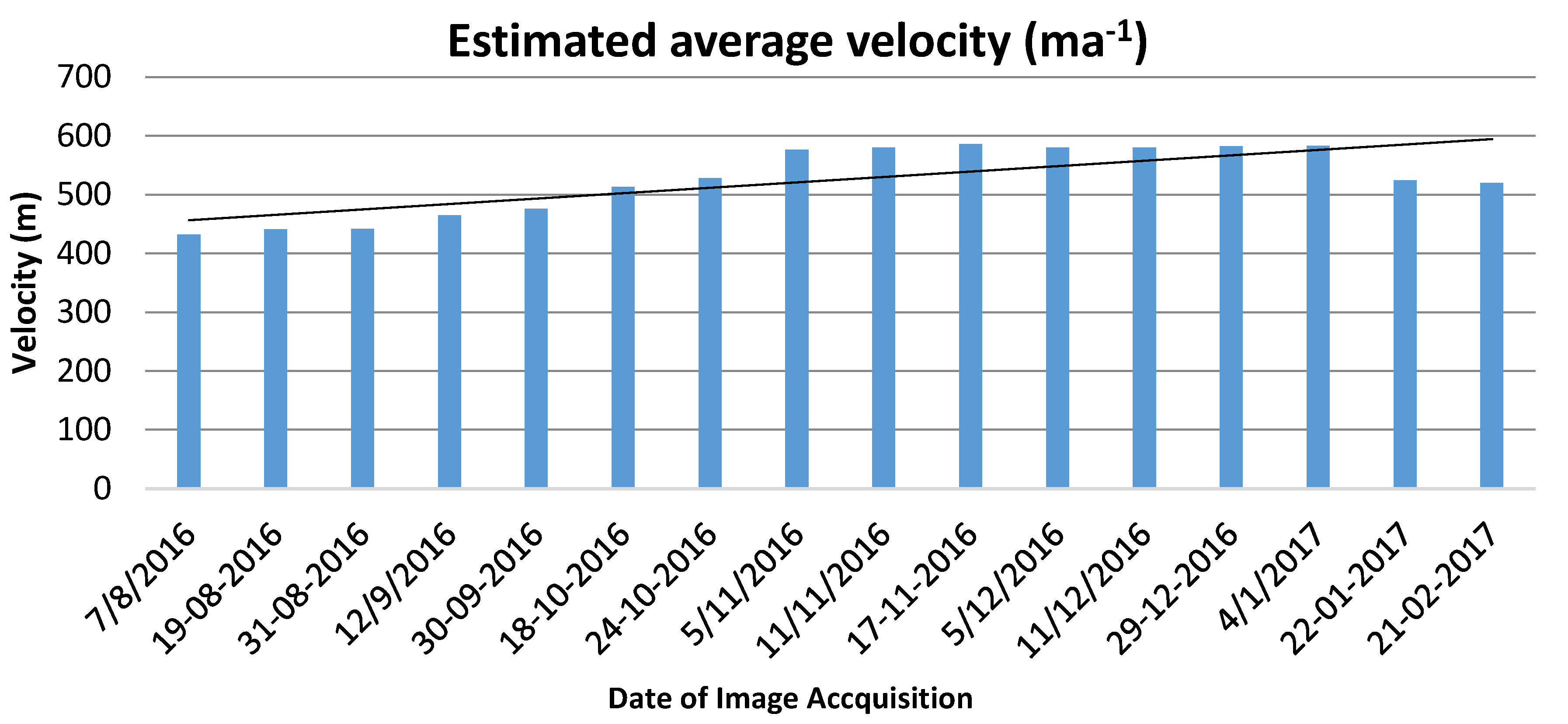Estimation of Velocity of the Polar Record Glacier, Antarctica Using Synthetic Aperture Radar (SAR) †
Abstract
:1. Introduction
2. Experiments
2.1. Study Area and Data Used
2.2. Methodology
Processing Steps for Velocity Calculation
3. Results and Discussion
4. Conclusions
Acknowledgments
Conflicts of Interest
Abbreviations
| PRG | Polar Record Glacier |
| SAR | Synthetic Aperture Radar |
| DEM | Digital Elevation Model |
| SLC | Single Look Complex |
| DInSAR or DiffSAR | Differential SAR interferometry |
| PSI or PSInSAR | Persistent scatterer interferometry |
References
- Goldstein, R.M.; Werner, C. Radar interferogram filtering for geophysical applications. Geophys. Res. Lett. 1998, 25, 4035–4038. [Google Scholar] [CrossRef]
- Massonnet, D.; Feigl, K. Radar interferometry and its application to changes in the Earth’s surface. Rev. Geophys. 1998, 36, 441–500. [Google Scholar] [CrossRef]
- Berardino, P.; Fornaro, G.; Lanari, R.; Sansosti, E. A new algorithm for surface deformation monitoring based on small baseline differential SAR interferograms. IEEE Trans. Geosci. Remote Sens. 2002, 40, 2375–2383. [Google Scholar] [CrossRef]
- Kenyi, L.; Kaufmann, V. Estimation of rock glacier surface deformation using SAR interferometry Data. IEEE Trans. Geosci. Remote Sens. 2003, 41, 1512–1515. [Google Scholar] [CrossRef]
- Berthier, E.; Vadon, H.; Baratoux, D.; Arnaud, Y.; Vincent, C.; Feigl, K.; Rémy, F.; Legrésy, B. Surface motion of mountain glaciers derived from satellite optical imagery. Remote Sens. Environ. 2005, 95, 14–28. [Google Scholar] [CrossRef]
- Strozzi, T.; Luckman, A.; Murray, T.; Wegmuller, U.; Werner, C. Glacier motion estimation using SAR offset-tracking procedures. IEEE Trans. Geosci. Remote Sens. 2002, 40, 2384–2391. [Google Scholar] [CrossRef]
- Dietrich, R.; Metzig, R.; Korth, W.; Perlt, J. Combined use of field observations and SAR interferometry to study ice dynamics and mass balance in Dronning Maud Land, Antarctica. Polar Res. 1999, 18, 291–298. [Google Scholar] [CrossRef]
- Zhou, C.; Zhou, Y.; Deng, F.; Ai, S.; Wang, Z.; Dongchen, E. Seasonal and interannual ice velocity changes of Polar Record Glacier, East Antarctica. Ann. Glaciol. 2014, 55, 45–51. [Google Scholar] [CrossRef]
- Anschütz, H.; Eisen, O.; Oerter, H.; Steinhage, D.; Scheinert, M. Investigating small-scale variations of the recent accumulation rate in coastal Dronning Maud Land, East Antarctica. Ann. Glaciol. 2007, 46, 14–21. [Google Scholar] [CrossRef]
- Bürgmann, R.; Rosen, P.; Fielding, E. Synthetic Aperture Radar Interferometry to Measure Earth’s Surface Topography and Its Deformation. Annu. Rev. Earth Planet. Sci. 2000, 28, 169–209. [Google Scholar] [CrossRef]
- Ferretti, A.; Prati, C.; Rocca, F. Nonlinear subsidence rate estimation using permanent scatterers in differential SAR interferometry. IEEE Trans. Geosci. Remote Sens. 2000, 38, 2202–2212. [Google Scholar] [CrossRef]
- Hellwich, O.; Ebner, H. Geocoding SAR interferograms by least squares adjustment. ISPRS J. Photogramm. Remote Sens. 2000, 55, 277–288. [Google Scholar] [CrossRef]
- Jawak, S.D.; Bidawe, T.; Luis, A. A Review on Applications of Imaging Synthetic Aperture Radar with a Special Focus on Cryospheric Studies. Adv. Remote Sens. 2015, 4, 163–175. [Google Scholar] [CrossRef]
- Jawak, S.D.; Luis, A.J. Prospective application of NASA-ISRO SAR (NISAR) in cryospheric studies: A practical approach. In Proceedings of the NISAR Science Workshop, Space Applications Centre (SAC), Ahmedabad, Gujarat, India, 17–18 November 2014. [Google Scholar]




| Parameters Specification | Parameters Specification |
|---|---|
| Polarization | HH |
| Incidence angle | 31°–46° |
| Azimuth Resolution | 20 m |
| Ground range resolution | 5 m |
| Azimuth and Rang look | Single |
| Swath | 250 km |
| Phase Error | 5° |
| Mission | Acquisition Date | Orbit Number | Id | Unique Identifier | Flight Direction |
|---|---|---|---|---|---|
| S1A | 07-08-2016 | 012500 | 0138DA | DA1D | Descending |
| S1A | 19-08-2016 | 012675 | 013E9C | 7FB2 | Descending |
| S1A | 31-08-2016 | 012850 | 01448E | 27DE | Descending |
| S1A | 12-09-2016 | 013025 | 014A22 | 2258 | Descending |
| S1A | 18-10-2016 | 013550 | 015B08 | 93BF | Descending |
| S1A | 11-11-2016 | 013900 | 0165F4 | 9EDC | Descending |
| S1A | 05-12-2016 | 014250 | 0170BC | 4526 | Descending |
| S1A | 29-12-2016 | 14600 | 017BB9 | C3E0 | Descending |
| S1A | 22-01-2017 | 014950 | 018671 | 6B79 | Descending |
| S1B | 30-09-2016 | 002304 | 003E57 | 540C | Descending |
| S1B | 24-10-2016 | 002654 | 0047CC | A1F8 | Descending |
| S1B | 05-11-2016 | 002829 | 004CA8 | F585 | Descending |
| S1B | 17-11-2016 | 003004 | 0051B4 | 7BAB | Descending |
| S1B | 11-12-2016 | 003354 | 005BA9 | C91B | Descending |
| S1B | 04-01-2017 | 003704 | 0065D5 | 6C7B | Descending |
| S1B | 21-02-2016 | 004404 | 007A9F | C99D | Descending |
| Date of Image | Average Coherence (0 to 1) | Estimated Average Velocity (ma−1) |
|---|---|---|
| 07-08-2016 | 0.76 | 432 |
| 19-08-2016 | 0.78 | 441 |
| 31-08-2016 | 0.81 | 442 |
| 12-09-2016 | 0.65 | 465 |
| 30-09-2016 | 0.82 | 476 |
| 18-10-2016 | 0.92 | 513 |
| 24-10-2016 | 0.90 | 528 |
| 05-11-2016 | 0.92 | 576 |
| 11-11-2016 | 0.94 | 580 |
| 17-11-2016 | 0.93 | 586 |
| 05-12-2016 | 0.88 | 580 |
| 11-12-2016 | 0.68 | 580 |
| 29-12-2016 | 0.79 | 582 |
| 04-01-2017 | 0.79 | 583 |
| 22-01-2017 | 0.78 | 524 |
| 21-02-2017 | 0.68 | 520 |
Publisher’s Note: MDPI stays neutral with regard to jurisdictional claims in published maps and institutional affiliations. |
© 2018 by the authors. Licensee MDPI, Basel, Switzerland. This article is an open access article distributed under the terms and conditions of the Creative Commons Attribution (CC BY) license (https://creativecommons.org/licenses/by/4.0/).
Share and Cite
H. Pandit, P.; Jawak, S.D.; Luis, A.J. Estimation of Velocity of the Polar Record Glacier, Antarctica Using Synthetic Aperture Radar (SAR). Proceedings 2018, 2, 332. https://doi.org/10.3390/ecrs-2-05145
H. Pandit P, Jawak SD, Luis AJ. Estimation of Velocity of the Polar Record Glacier, Antarctica Using Synthetic Aperture Radar (SAR). Proceedings. 2018; 2(7):332. https://doi.org/10.3390/ecrs-2-05145
Chicago/Turabian StyleH. Pandit, Prashant, Shridhar D. Jawak, and Alvarinho J. Luis. 2018. "Estimation of Velocity of the Polar Record Glacier, Antarctica Using Synthetic Aperture Radar (SAR)" Proceedings 2, no. 7: 332. https://doi.org/10.3390/ecrs-2-05145







